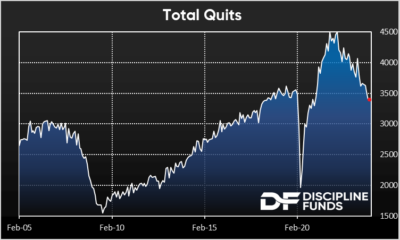One of the main drivers in the falling rate of inflation has been the consistently softening labor market. The Covid stimulus and recovery resulted in a huge employment surge. The unique nature of the boom and the work from home policies gave workers unprecedented negotiating power. For a brief moment in time it even looked like a return of the 1970s and a wage price spiral was a real possibility. But as we all know now, things are normalizing and they’re normalizing quickly now.

Tuesday’s JOLTs report and the quit rate, in particular, confirmed the stance of capital vs labor in this environment and capital is clearly gaining the upper hand here. Total quits actually fell to levels below the pre-Covid levels as workers are now losing the optionality they enjoyed during Covid. The mean reversion in nearly everything is happening. Some of which is good and some of which is not so good.
This is an especially interesting piece of data in the context of all the crazy things we’ve seen in the last few years. One way of reading this is that we’re just back to the pre-Covid style environment where the labor market was modestly strong, but not so strong that it could cause high inflation. Another way of reading this is that the labor market is deteriorating and there is a rising risk that the Fed has overtightened. Both views are reasonable views in my opinion and I think investors would be wise to be prepared for both outcomes. That is, if your baseline scenario is a 75% probability of what I’ve called a “muddle through” environment as we revert to the pre-Covid mean then there’s still a 25% chance that the other scenario occurs where the labor market softens materially this year and the Fed actually ends up cutting because the labor market is at risk of softening much more than the Fed would like.
In any case, I think the inflation story is becoming increasingly clear here. Disinflation is broadly entrenched, a wage price spiral is now a very low probability outcome, the return of the 70s is not happening and the risk to inflation is actually to the downside, not the upside.
As for the Fed – it looks like full steam ahead on cuts by the Summer. My guess is they sit tight on rates this week and the data in the coming months will determine whether we get a cut at the March, May or June meeting. I’ve still got my eye on June, but if we get more labor market softening then May starts to look like the first cut.
